Downloads
***Check against delivery***
It’s yet again a huge pleasure to be with the European Australian Business Council. I have spoken here on a number of occasions and have always enjoyed these engagements.
Perhaps unsurprisingly, today I’m in the frame of mind to reflect a little on the some of the major economic reforms that have happened over the course of my career, and how they have affected the Australian economy.
So, as they say in the classics, let’s start in the beginning.
I first joined the Treasury more than three decades ago. For me, it was a temporary stop on the path to becoming an academic. Working for the public service was a means of gaining some experience — and some cash — before going on to do further studies.
If you had told me in 1981 that I would stay on long enough to be able to speak to you tonight as Treasury Secretary, then I would have been shocked. I dare say John Stone, the Secretary at the time, would have been shocked as well!
Of course, I have managed in those 30-something years to get out of the Treasury building and do a few other things. I went back to university as I had planned, and did a Ph.D., which I had not! I worked in Parliament House for Treasurer John Dawkins as we struggled to guide Australia out of the early 1990s recession, much of which can be attributed to business, consumers and policy-makers trying to adjust to an increasingly globalised world. I worked at the IMF for four years in the late 1990s, covering the period of the Asian financial crisis and its aftermath – itself echoes of the adjustment challenge Australia had faced less than a decade earlier. And, obviously, I worked on Australia’s policy response to climate change.
But the range of interesting, challenging and important policy issues that I was able to work on in Treasury kept me coming back.
Apart from the path my career would take, the other thing that I would not have believed in 1981 is that Australia would eventually experience 23 years and counting of uninterrupted economic growth. After the experience of the 1970s — of low growth, high inflation and increasing unemployment — that would have seemed an improbable outcome.
The third thing that I would not have envisaged in 1981 is that Australian governments would undertake a series of politically tough economic reforms through the 1980s, 1990s and 2000s that would deliver unprecedented increases in national income and more stable economic growth.
I am making the younger Martin sound rather incredulous, but I think if you had described to anyone in 1981 the reforms that successive Australian governments would make to financial markets, to labour markets, to trade and industry policy, to competition policy, and to the way that fiscal and monetary policy are run… well, I don’t think they would have believed you. There was simply very little anticipation of the reform process that was to come, in part because of the sense of the burning platform that was so apparent by the mid-1980s was only just beginning to form in the public consciousness.
Moreover, there was little anticipation, either by the public or by policy-makers, of the magnitude of the changes that these reforms would prompt in Australia’s economic performance.
If you had described the Asian financial crisis — a major collapse in the economies of many of our nearest trading partners in the late 1990s — to people in 1981, most would have agreed that it sounded like a recipe for an Australian recession. Similarly, the bursting of the technology bubble and subsequent recession in the United States in the early 2000s would have been expected to result in a recession in Australia, as would the global financial crisis of 2008.
So looking back now at these events — the Asian financial crisis, the tech wreck and the global financial crisis — the questions are, “what changed in our economy that made its response to these events so much better than the experience of the 1970s, 80s and early 90s would have suggested was possible?” “How did these economic reforms change the economy for the better?” And “How were these reforms conceived and implemented?”.
These are the things that I would now like to reflect on in a little more detail: Australia’s economic experience in recent decades; the economic reforms that helped to boost our national income and produce more sustainable economic growth; the courage of governments in implementing those reforms; and the fragility of the reform process.
I won’t speak any more about my own career, but the remainder of this speech reflects my journey as a policy adviser and some of the things that I have learnt on the way. I feel lucky to have worked in Treasury in a period when governments have been willing to tackle difficult reforms and to stay long enough to see some of the payoffs from those reforms.
Stable growth and higher incomes
So let me start with a bit of economic history.
Most of you would know that the last time Australia experienced an economic recession was in the early 1990s, more than two decades ago.
For those of you with good memories, 1990-91 was the last fiscal year in which economic activity fell. We have had 23 years of uninterrupted economic growth since then, and we are now almost halfway through 2014-15, the 24th year of growth.
For those of us of a certain age, it can be startling to think that many of our colleagues — indeed, many of the senior leaders in our organizations — had not even joined the workforce in 1990-91. They have never experienced a recession in their working lives. To put a number on this, around 50 per cent of people in today’s working age cohort (15-64) were not old enough to work at the time of the 1990-91 recession.
That is not to say that the economy has not experienced periods of slower growth in that time — it certainly has — but those periods of slower growth have not resulted in recessions.
Let me give you some comparisons using the unemployment rate — not a perfect measure of economic conditions (no single statistic is), but a very useful summary nevertheless.
Chart 1: Income per capita comparisons
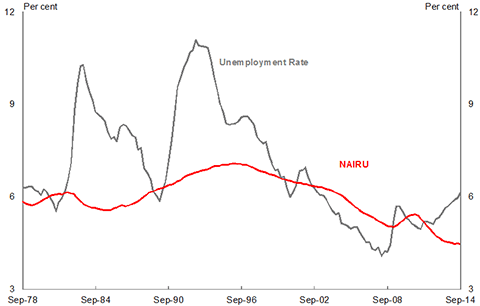
Source: ABS Cat. no. 6202.0 and Treasury.
Following the bursting of the technology bubble in the United States in 2000-01, our unemployment rate increased by around a percentage point, peaking at 7.2 per cent at a time when we thought the normal rate of unemployment (the NAIRU) was around 6.5 per cent.1
During the global financial crisis, it went up by around 2 percentage points, peaking at 5.9 per cent, when the NAIRU was thought to be around 5 per cent.
And in the past year, with the effects of still sluggish world growth and falling export prices for Australia, it has increased by around one percentage point to its current level of 6.2 per cent, also with a NAIRU estimated at around 5 per cent.
In each of these slowdowns, the unemployment rate has increased to around 1 percentage point above the NAIRU.
Compare this with what happened in the 1990s recession. The unemployment rate went from 5.8 per cent in December 1989 to 11.1 per cent in October 1992, an increase of more than 5 percentage points.
Looking back further to the early 1980s recession, the unemployment rate rose from 5.4 per cent in June 1981 to 10.3 per cent in May 1983, an increase of almost 5 percentage points. A similarl
y large increase of around 4 percentage points took place from the mid to the late 1970s, albeit over a slightly longer period as we grappled with stagflation.2
Those recessions of the 1970s, 80s and 90s were devastating to the economy. There was the direct loss to economic output of having around 5 per cent of our workforce thrown out of jobs. And there were the social and personal costs of increased unemployment that are more difficult to measure, but likely just as large, or larger, and more persistent, than the direct loss to economic output.3
Large numbers of people experienced long periods of unemployment following these recessions. In many cases, those long-term unemployed never worked again. It is likely that this is one factor that contributed to the boost in claims for disability support pensions following the 1990-91 recession.
This is a sobering thought — many of the people who lost their jobs during these recessions never regained employment. This was a tragedy for the people concerned, a tragedy for their families, and a tragedy for our society.
So the point that I would like you to take from this chart is that the economy experienced stop-start growth in the twenty years before the 1990s recession with periods of high unemployment leading to many people leaving the labour market for good. In the two decades since, periods of rising unemployment are evident, but they are less severe and have not resulted in the same massive increases in long-term unemployment as the earlier period – in short, both hours worked and real wages have moved in ways that act as a shock absorber with, I would contend, huge economic and social payoffs.
Chart 2: Income per capita comparisons
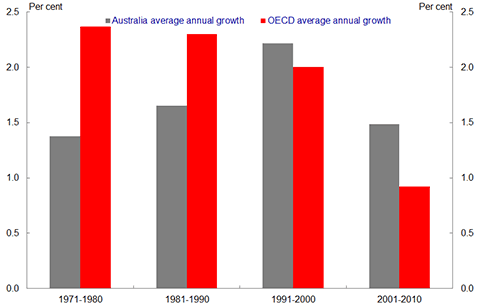
Source: World Bank and Treasury.
Let me show you a second chart that shows Australia’s per capita income ranking in the OECD. You would know that the OECD is sometimes referred to as the rich countries’ club, so the members of the OECD tend to be those at a comparable stage of development to Australia.
You can see that by the 1970s and 1980s, Australia’s per capita income was falling relative to that of other advanced economies. That is, our per capita income was tending to increase over time, but at a slower rate than other countries at a comparable stage of development.
In simple language, we were slipping behind the other advanced economies, while the so-called Asian tigers were coming up fast from behind. Indeed, it was this that led to the then Singaporean Prime Minister, Lee Kuan Yew, warning Australians were on track to become “the poor white trash of Asia”.
But from the mid-1990s on, this position began to change. Australia’s per capita income began to increase more quickly than its peers, our ranking rose accordingly, and emerging economies started to look at our policies as a model to emulate, rather than avoid.
The two facts that I have given you are not unrelated of course. If you have a large recession, your per capita income is going to fall. But recessions are temporary — they can do a lot of damage, they can take years to recover from, but the recovery does happen eventually.
This improvement in Australia’s trend rate of income growth compared with other advanced economies tells you that, as hard as these other countries were running, we were running harder.
From about 2003, Chart 2 is a little misleading as this marks the start of the mining boom. As shown in Chart 3, much of the increase in our national income (gross national income per capita) from 2003 came from increases in the prices received for our commodity exports, while our economic growth rate (gross domestic product per capita) slowed.
Chart 3: Increase in national income from mining boom
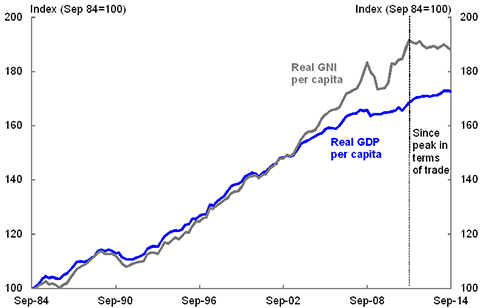
Source: ABS Cat. no. 5206.0 and Treasury
So, there are two very powerful things that changed in the economy in the past two decades relative to the previous two decades. Firstly, our economy has grown at a more stable pace, while economic slowdowns have tended to be shorter and of smaller magnitude than they were previously. And second, our trend rate of income growth has tended to be higher than our peers’, where previously it was lower.
Chart 4: Economy growing at a more stable pace
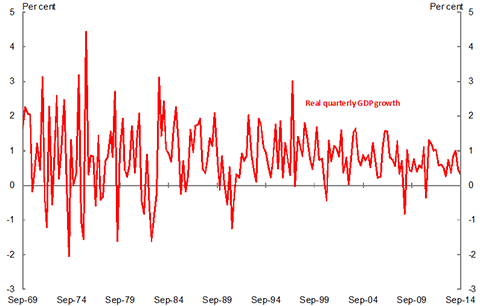
Source: ABS Cat. no. 5206.0 and Treasury.
Economic reform
Let me now turn to the areas of economic reform that have been important in helping to move the economy from the period of stop-start growth, rising unemployment and declining relative living standards to that of more stable growth and rising relative incomes.
I will group these reforms under three headings:
- First, the changes to product and labour markets that have increased the economy’s ability to adjust to changes in economic circumstances and to deliver better products and services for consumers. The floating of the dollar, banking sector reform and labour market reform fit here.
- Secondly, improvements in the conduct of macroeconomic policy. The frameworks for monetary and fiscal policy are now more transparent and the outcomes have improved.
- And thirdly, the creation of an institutional framework that is able to deliver tough, independent policy advice, through organisations like the Productivity Commission, and implement policy in particular areas within clearly specified frameworks, like the Reserve Bank in monetary policy and the Australian Competition and Consumer Commission in competition policy and consumer protection.
To be clear, my argument is that these reforms by government were an important pre-condition for stronger and more stable growth. I do not mean by this to argue that governments are responsible for creating economic growth; rather that they have a critical role in creating the enabling environments and providing the incentives for growth to occur. Getting these enablers and incentives wrong can influence growth outcomes.4
Australia is not immune from economic cycles. But the economic reforms of the 1980s, 1990s and 2000s mean that recessions will happen less frequently and be less severe, on average, than if we still had the economic policies and structures of the 1970s.
Reforms to financial, product and labour markets
So let me start with a list of some of the reforms that opened our internal product and labour markets to more domestic and international competition.
On the financial market side, there was the floating of the dollar in 1983, the removal of foreign exchange controls, and the opening of the banking sector from the mid-1980s to increased foreign competition.
On the trade side, there was a programme of unilateral reforms under the Hawke, Keating and Howard governments that, over a number of years, reduced most import tariffs to low levels and removed many non-tariff barriers to trade. These followed an earlier large reduction in tariff rates by the Whitlam government that was motivated mainly by a desire to reduce inflation, but achieved this objective in part through a greater exposure of the economy to foreign competition.
An important point to note is that these trade reforms were unilateral – we didn’t hold back from reforms in o
rder to husband bargaining chips for negotiation with others.
In the area of industry and competition policy, there were many individual reforms that put the consumer at the forefront of policy considerations. Reforms in industry sectors like aviation and automobile manufacturing were started under Hawke and continued by his successors.
It has long been a fact of life in Australia that industry policy has often favoured producer interests at the expense of consumers. Over time, however, governments have been increasingly wary of helping unprofitable firms to remain in the marketplace, instead shifting their focus to assisting with the economic adjustment process — the current government’s response to the threat of exit of automobile manufacturers from Australia being the most marked manifestation.
On labour market policies, the changes that the Keating and Howard governments made to move to a system of enterprise or individual bargaining on wages and conditions was a massive change to the internal working of the economy. Up until the 1980s, the system of centralised wage fixation meant that signals on relative labour demand in different parts of the economy were suppressed. As a result, resources failed to move to where they were most valued.
Not only did this mean we lost wealth-creating opportunities, this system, combined with the absence of a floating exchange rate, propagated external shocks or impulses throughout the entire labour market. The result was that adjustment occurred via the number of people employed, rather than through real wages or hours worked. This contributed directly to the large social costs of high and sustained unemployment mentioned earlier.
In the more decentralised system we have today, changes in relative wages signal the need for labour in different industries or firms, while the floating exchange rate helps buffer the economy from external shocks.
Chart 5: Wage levels by industry
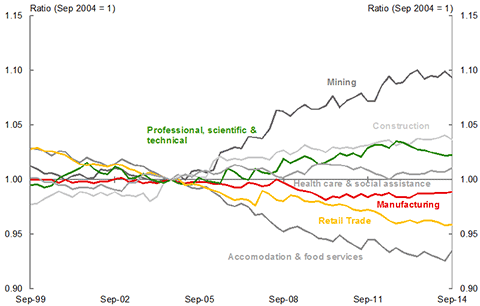
Source: ABS Cat. no. 6345.0 and Treasury.
A milestone in the approach to retirement income policy in Australia took place with the introduction of compulsory savings through the Superannuation Guarantee in the early 1990s. In the mid-1980s, only a minority of Australians had superannuation and contribution rates were insufficient to materially improve retirement incomes for the average worker.
A little over two decades later, Australians now have more than the equivalent of our country’s national income in accumulated superannuation assets. This has had a significant impact on the adequacy of the incomes of those entering retirement now and in the future, and also on the stability of our financial system and our economic growth. It will also, over time, take some pressure off age pension expenditures.
Economists usually group these types of reforms under the heading of microeconomic reform, although the reach of many of them is probably more macroeconomic than microeconomic. Reforms of this nature offer the prospect of improved allocation of capital and labour, towards production of the goods and services most in demand — thus producing an increase in national income — and of improving the flexibility of the economy in the face of external changes. Australia would not have passed so smoothly through the Asian financial crisis or the mining boom in the absence of these reforms.
As a small and open economy, and as a large commodity exporter, Australia is subject to large external shocks. Having an economy that is able to flexibly adjust to changed circumstances, through currency movements or wage adjustments, is necessary to smooth adjustment and minimise the risk of recession. And as a large importer of foreign capital for investment, we need price signals that direct investment to the areas of highest return for the economy.
These reforms to financial, product and labour markets were initially motivated by the argument that Australia needed to be more competitive internationally. This was a sensible approach — it offered a compelling rationale to the public of the imperative for reform — although reform also produced valuable changes in some of the less-traded sectors of the economy.
Facts like Australia’s relative income ranking falling through the 1970s and 1980s were also important motivators of the need for reform, as was the hand-wringing over the current account deficit in the mid- to late-1980s.
There are many areas of the economy today that are still in need of a reformist eye. The provision of public services in health, education, utilities and transport come to mind. That sounds like enough for starters. But I do worry that without the proximate motivation for reform that we had in the 1980s, we risk moving too slowly. On the labour market for instance, the discussion of reform is close to a no-go area, but it really is critical to our future success that we be willing to change where that is sensible.
That is not to say that we should not think about the context for reform. I think that one of the reasons for the success of past labour market reforms has been that the process has been managed while maintaining the social contract — movements in Australia’s rates of employment and income inequality, for example, look a lot better than changes in similar measures in the US. It helps the reform process if people see the benefits, although I recognise that this can be difficult.
Chart 6: Australia & US comparison employment to population ratio
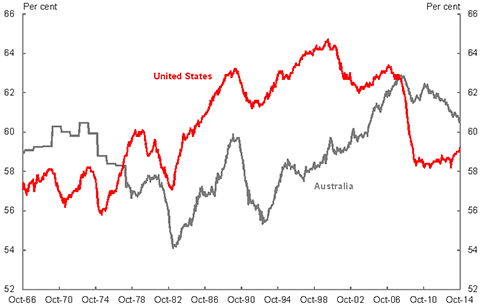
Source: ABS Cat. no. 6202.0 and 3105.0.65.001, OECD and Treasury.
Chart 7: US hourly real wages growth by decile 1979-2011
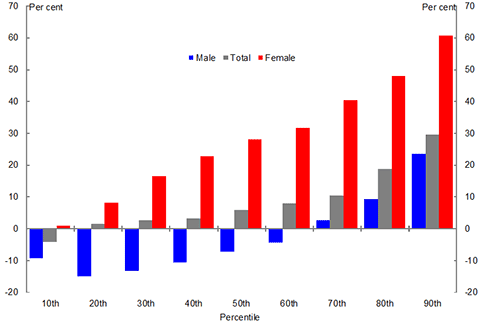
Source: Economic Policy Institute, The State of Working America, 12th edition and Treasury.
Reforms to macroeconomic management
The second major area of reform that I want to mention is to the conduct of macroeconomic policy.
A corollary of floating the Australian dollar was that Australia was able to run an independent monetary policy — to set its own interest rates — and use this as a tool to manage demand in the economy. It had become widely accepted in the years leading up to the early 1990s that monetary policy could best contribute to sustainable economic growth by achieving low and stable inflation.
Following the 1990s recession, inflation fell sharply and RBA Governor Bernie Fraser used this as an opportunity to establish a target for inflation of between 2 and 3 per cent on average, over the cycle. This target was formalised by an exchange of letters between Treasurer Costello and Governor Macfarlane in 1996, ensuring the operational independence of the Reserve Bank to direct monetary policy towards the inflation target. This commitment has been maintained by successive Treasurers and Governors.
It is difficult to argue that the inflation-targeting framework has been anything other than a success for Australia. Inflation outcomes have remained consistent with the target for twenty years, coinciding with the period of remarkable growth in the economy. And the Reserve Bank has built up a large amount of credibility for its commitment to the target, giving it important flexibility to accommodate temporary periods of higher or lower inflation for which monetary policy is not the right response.
On fiscal policy, Treasurer Costello introduced the Charter of Budget Hone
sty. The Charter requires a range of actions including the regular production of fiscal strategy statements and the production of intergenerational reports that consider the long-term sustainability of fiscal policy.
As a result of the Charter, Australia’s fiscal policy is conducted in a more transparent and accountable framework and carries greater credibility with ratings agencies and investors – credibility that many other countries envy. This fiscal credibility is particularly important for a small open economy reliant on foreign capital to maintain high rates of investment.
The Charter requires governments to explain short-term fiscal policy actions in the context of longer-term goals for fiscal sustainability. This transparency around strategy lends credibility to the government’s actions.
It is this lack of established fiscal credibility for a number of national governments in Europe that has meant the EU has had to maintain a strong focus on fiscal austerity in an environment where a preferable response would be at least to maintain levels of government spending. They cannot do this because they do not have the credibility needed to convince markets of their commitment to running tighter fiscal policy in the future to pay back debts incurred today.
But as helpful as Australia’s medium term approach to fiscal policy has been since the mid-1990s, increasingly the public debate plays out in ways that seem to assume that fiscal sustainability is irrelevant to Australia’s future prosperity.
As I have said publicly many times – a point reinforced by both the Governor of the RBA and the head of the independent Parliamentary Budget Office – Australia has a structural problem at the heart of the budget. Without action, we are on track for a decade of deficits, rising debt and increasingly constrained policy flexibility in the face of future shocks.
Reforms to the institutional framework
The final area of reform that I want to talk about is the building of institutions that are able implement policy and deliver sound advice to Government.
There are many areas in which governments have built up institutions to implement policy at arm’s length from the political process. I have just mentioned the Reserve Bank. There are many others: the Australian Prudential Regulation Authority, the Australian Securities and Investments Commission, the Australian Competition and Consumer Commission, the Australian Taxation Office. These are some of the largest but the list goes on.
Today the operational independence of these regulators from government, and from the pressures of political processes, is unremarkable. But these institutions have been built up over many years and their credibility to act independently has been enhanced by the commitment of successive governments to respecting the bounds of that independence.
There are also institutions that advise on new areas for reform. The Productivity Commission – which is the Australian Government’s independent research and advisory body on a range of economic, social and environmental issues affecting the welfare of Australians - is a giant in this field and fairly unique in the world. Tracing its lineage back to the Tariff Board of the 1920s, the PC became the Industries Assistance Commission in 1974, the Industry Commission in 1990 and the statutorily independent Productivity Commission under the Howard Government in 1998.
Through these changes in name, you can see the evolution of the PC’s focus, but it is through its actions that it has built its reputation as a competent, thorough, and thoroughly independent adviser to Government. It has been influential in many of the areas of economic reform that I have mentioned and it continues to be a centre of excellence for the production of good policy advice to governments.
The independence of these regulators and advisers is a critical element of their success. That successive governments have respected that independence, despite no doubt disagreeing at times with individual regulatory decisions or policy recommendations, has enhanced the ability of these institutions to do their jobs. Their ‘brand names’ have become critical to their success and governments have chosen to invest in these brands rather than undermine them.
It is important that all of Australia’s key economic institutions, and the political process, recognize that credibility is hard earned and easily destroyed.
Maintaining bipartisan commitment to core elements of our framework for implementing and improving policy, and to improving our institutions, will be important if we are to be optimistic for the future of the reform process.
Conclusion
The conclusion that I would like you to take away is that the 23 years of continuous economic growth that Australia has experienced — and we’re on our way to the 24th — was neither an accident nor was it easy. It was built on the tough decisions made by governments in the 1980s, 1990s and 2000s.
And they were politically tough decisions, no doubt about it. Changes to labour market policy and industry policy in particular were tough then and are still tough today. But governments were able to build up motivating rationales that were compelling to the public — of the need to be internationally competitive for example, or of the need to have sustainable government finances for the sake of future generations’ standards of living.
The challenges and opportunities facing Australia in the next few decades will differ from those we faced in the past. I explored these challenges and opportunities in my address to the Committee for Economic Development in Australia last week. However, I am confident that, the economic frameworks and institutions we have put in place will combine with an ongoing commitment to reform by successive Australian governments to ensure we are likely to be in a position to seize those opportunities and create a path to continuing prosperity.
I think Australia has a great track record for generating and implementing good public policy ideas, amongst the best in the world in fact. We need to continue to nurture the institutions that have delivered this track record and we need to continue to invest in the type of policy that will help deliver stable growth and higher living standards in the future for the good of all Australians.
Thank you for the opportunity to be with you for this, my final address as Treasury Secretary.
1 By normal rate of unemployment, I mean the non-accelerating inflation rate of unemployment (NAIRU) — a rate of unemployment that is consistent with stable inflation. This rate will be above zero because it includes people who are moving between jobs and people who are willing to work but cannot readily be employed with their current skills or at their current location.
2 The combination of slow (or stagnant) growth and persistent inflation.
3 See the discussion in Australian Bureau of Statistics Australian Social Trends, March 2010, The labour market during recent economic downturns (ABS Cat. No. 4102.0) and Borland, J and Kennedy S (1998) Dimensions, Structure and History of Unemployment, CEPR Discussion Papers 388, Centre for Economic Policy Research, Research School of Economics, Australian National University.
4 Banks G (2012) Productivity policies: the 'to do' list, speech to the Economic and Social Outlook Conference delivered on 1 November 2012 provid
es a list of reforms to improve productivity and is referred to in Stevens G (2012) Producing Prosperity.